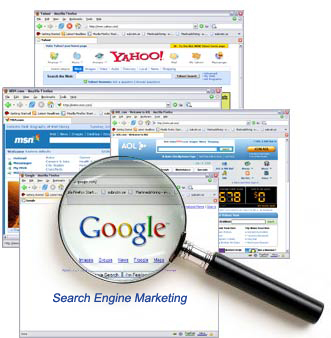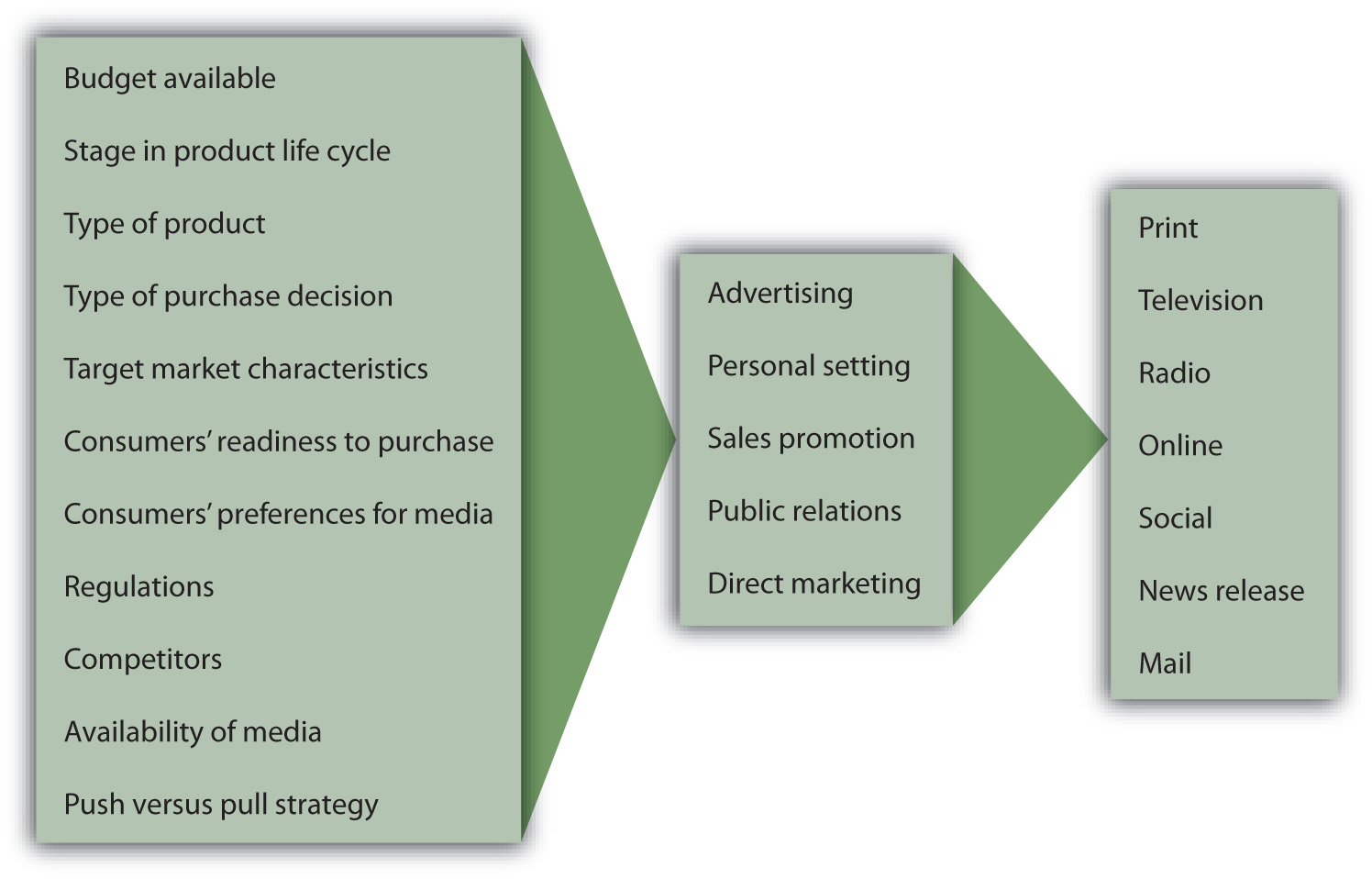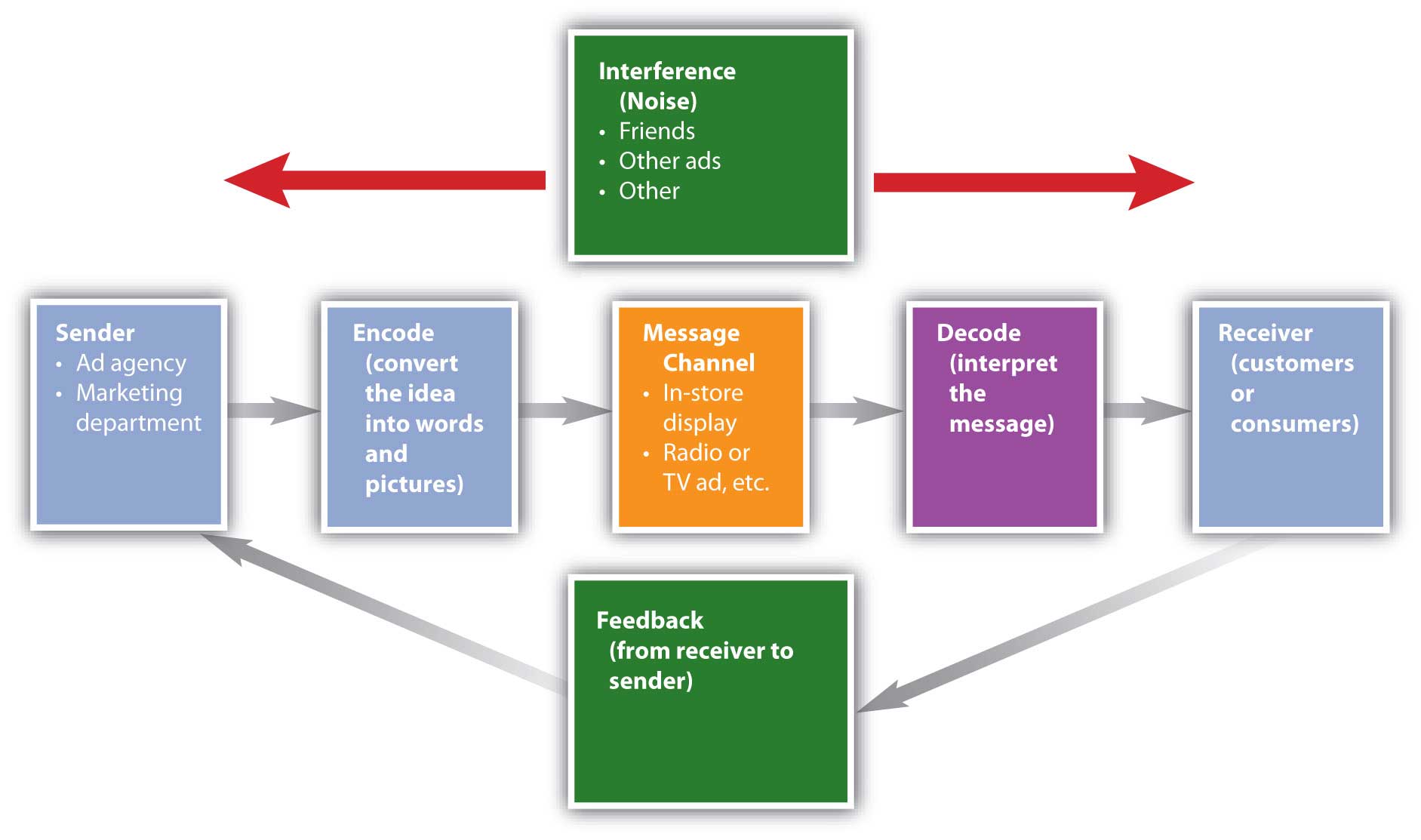Learning Objectives
The objectives of this section is to help students …
- Understand what integrated marketing communications (IMC) are.
- Understand why organizations may change their promotional strategies to reach different audiences.
- Understand the different components of the promotion (communication) mix and why organizations may consider all components when designing the IMC program.
- Understand the difference between types of communication that target many people at one time versus types of communication that target individuals.
- Understand the factors that influence selection of the promotion mix.
- Understand the communication process and message problems.
Once companies have developed products and services, they must communicate the value and benefits of the offerings to current and potential customers in both business-to-business (B2B) and business-to-consumer (B2C) markets. Integrated marketing communications (IMC) provide an approach designed to deliver one consistent message to buyers through an organization’s promotions that may span all different types of media such as TV, radio, magazines, the Internet, mobile phones, professional selling, and social media. For example, Campbell’s Soup Company typically includes the “Mm, mm good” slogan in the print ads it places in newspapers and magazines, in ads on the Internet, and in commercials on television and radio. Delivering consistent information about a brand or an organization helps establish it in the minds of consumers and potential customers across target markets. Although the messages are very similar, Campbell’s uses two variations of commercials designed to target different consumers. Watch the following two YouTube videos. You’ll notice that the message Campbell’s gets across is consistent. But can you figure out who is in the two target audiences?
Video Clip A Meal : That’s Always Popular with the Group
https://www.youtube.com/watch?v=W5ZM1cqpdT0
Campbell’s soup provides a good meal.
Video Clip : So Many Possibilities for Enjoying Soup
https://www.youtube.com/watch?v=IN3c4rZJNd4
Campbell’s soup pleases people of all ages.
Changes in communication technology and instant access to information through tools such as the Internet and social media (online communication among interdependent and interconnected networks of organizations, people, and communities) explain one of the reasons why integrated marketing communications have become so important. Consumers are also changing. With access to many sources of information and often an interest in interactive media, consumers may collect more product information on their own. Marketers must organize and assemble available information to build a consistent brand message and make it relevant. With IMC, organizations can coordinate their messages to build the brand and develop strong customer relationships while also helping customers satisfy their needs.
FedEx’s recent campaign, the “We Understand” tagline launched in 2009 and the “Solutions that Matter” tagline launched in 2011, illustrate examples of IMC campaigns they used to deliver a consistent message across all media channels including television commercials, e-mails, social media, mobile marketing, direct mail, and the FedEx channel on YouTube (Dilworth, 2010). Watch the following videos to see examples of commercials in the FedEx campaigns.
Video Clip : The “We Understand” at FedEx Shows Customers that They Understand and Can Satisfy Their Needs
https://www.youtube.com/watch?v=Et1oZPNf2d0
FedEx often uses a humorous appeal.
Changing Media
Many consumers and business professionals seek information and connect with other people and businesses from their computers and phones. The work and social environments are changing, with more people having virtual offices and texting on their cell phones or communicating through social media sites such as Facebook, LinkedIn, Pinterest, and Twitter. As the media landscape changes, the money that organizations spend on different types of communication will change as well. Some forecasts indicate that companies will spend almost 27 percent of their total promotional budgets, or $160 billion, on electronic or non-traditional media by 2012.

Figure 11.1: Changing media
Some consumers feel lost without their cell phones. Phones such as the one pictured provide a source of information for consumers and a new medium for advertisers to deliver information.
(Yeray Hdez Guerra – iPhone – CC BY 2.0.)
Many college students are part of the millennial generation, and it is consumers from this generation (people like you perhaps) who are driving the change toward new communication technologies. You might opt to get promotions via mobile marketing—say, from stores on your cell phone as you walk by them or via a mobile gaming device that allows you to connect to the Web. Likewise, advertisements on Facebook are popular as businesses continue to utilize more social media. For example, when Honda let people on Facebook use the Honda logo to give heart-shaped virtual gifts on Valentine’s Day, over one and a half million people participated in the event and viewed the Honda Fit online in the process. Imagine the brand awareness generated for the Honda Fit.

Figure 11.2: Search engine marketing
Marketing based on the Internet and wireless technology is popular.
(Danard Vincente – Search-Engine-Marketing – CC BY 2.0.)
Traditional media (magazines, newspapers, television) compete with media such as the Internet, texting, mobile phones, social media, user-generated content such as blogs, and YouTube as well as out-of-home advertising such as billboards and movable promotions. You might have noticed that the tray tables on airplanes sometimes have ads on them. You have probably also seen ads on the inside of subway cars, in trains and buses, and even in bathroom stalls. These, too, are examples of out-of-home advertising.

Figure 11.3: Out-of-home advertising
The inside walls of many subways provide an opportunity for advertisers to reach commuters with their messages.
(emilydickinsonridesabmx – Vintage NYC Subway Trains – CC BY 2.0)
Although the money organizations spend promoting their offerings may go to different media channels, a company still wants to send its customers and potential consumers a consistent message (IMC). The different types of marketing communications an organization uses compose its promotion or communication mix, which consists of advertising, sales promotions, direct marketing, public relations and publicity, sponsorships (events and experiences), social media and interactive marketing, and professional selling. The importance of IMC will be demonstrated throughout the discussion of traditional media as well as newer, more targeted, and often interactive online media.
Advertising involves paying to disseminate a message that identifies a brand (product or service) or an organization being promoted to many people at one time. The typical media that organizations utilize for advertising of course include television, magazines, newspapers, the Internet, direct mail, and radio. Businesses also advertise on mobile devices and social media such as Facebook, blogs, and Twitter.
Consumer sales promotions consist of short-term incentives such as coupons, contests, games, rebates, and mail-in offers that supplement the advertising and sales efforts. Sales promotions include promotions that are not part of another component of the communication mix and are often developed to get customers and potential customers to take action quickly, make larger purchases, and/or make repeat purchases.
In business-to-business marketing, sales promotions are typically called trade promotions because they are targeted to channel members who conduct business or trade with consumers. Trade promotions include trade shows and special incentives given to retailers to market particular products and services, such as extra money, in-store displays, and prizes.
Direct marketing involves the delivery of personalized and often interactive promotional materials to individual consumers via channels such as mail, catalogs, Internet, e-mail, telephone, and direct-response advertising. By targeting consumers individually, organizations hope to get consumers to take action.
Professional selling is an interactive, paid approach to marketing that involves a buyer and a seller. The interaction between the two parties can occur in person, by telephone, or via another technology. Whatever medium is used, developing a relationship with the buyer is usually something the seller desires.
When you interview for internships or full-time positions and try to convince potential employers to hire you, you are engaging in professional selling. The interview is very similar to a buyer-seller situation. Both the buyer and seller have objectives they hope to achieve. Business-to-business marketers generally utilize professional selling more often than most business-to-consumer marketers. If you have ever attended a Pampered Chef party or purchased something from an Amway or Mary Kay representative, you’ve been exposed to professional selling.
 Figure 11.4: Professional Selling
Figure 11.4: Professional SellingPampered Chef and Tastefully Simple have built their businesses primarily on the professional selling skills of their consultants. Professional selling is used more in business-to-business markets than in business-to-consumer markets.
[Wikimedia Commons – public domain.]
Public relations (PR) involves communication designed to help improve and promote an organization’s image and products. PR is often perceived as more neutral and objective than other forms of promotion because much of the information is tailored to sound as if it has been created by an organization independent of the seller. Public relations materials include press releases, publicity, and news conferences. While other techniques such as product placement and sponsorships, especially of events and experiences, tend to generate a lot of PR, the growth of expenditures and importance of sponsorships are so critical for so many companies that it is often considered a separate component in the communication mix. Many companies have internal PR departments or hire PR firms to find and create public relations opportunities for them. As such, PR is part of a company’s promotion budget and their integrated marketing communications
Sponsorships typically refer to financial support for events, venues, or experiences and provide the opportunity to target specific groups. Sponsorships enhance a company’s image and usually generate public relations. With an increasing amount of money being spent on sponsorships, they have become an important component of the promotion mix.
A marketing manager from one company might decide to focus on social media, whereas a marketing manager from another company might decide to focus her company’s efforts on television commercials. Why do companies select different types of media for what may be perceived as similar messages? As Figure 11.5 “Factors That Influence Selection of Promotion Mix” shows, a number of factors affect the choice of promotion mix elements.
Factors That Influence Selection of Promotion Mix
Budget Available: For many companies, the budget available to market a product determines what elements of the promotion mix are utilized. The budget affects a promotion’s reach (number of people exposed to the message) and frequency (how often people are exposed). For example, many smaller companies may lack the money to create and run commercials on top-rated television shows or during the Super Bowl. As a result, they may not get the exposure they need to be successful. Other firms such as McDonald’s may come up with creative ways to reach different target markets. For example, McDonald’s targeted college students with a special promotion that it filmed live in a Boston University lecture.
Stage in the product life cycle: The stage in the product life cycle also affects the type and amount of promotion used. Products in the introductory stages typically need a lot more promotional dollars to create awareness in the marketplace. Consumers and businesses won’t buy a product if they do not know about it. More communication is needed in the beginning of the product life cycle to build awareness and trial.
Type of product and type of purchase decision: Different products also require different types of promotion. Very technical products and very expensive products (high involvement) often need professional selling so the customer understands how the product operates and its different features. By contrast, advertising is often relied upon to sell convenience goods and products purchased routinely (low involvement) since customers are familiar with the products and they spend relatively little time making purchase decisions.
Target market characteristics and consumers’ readiness to purchase: In order to select the best methods to reach different target markets, organizations need to know what types of media different targets use, how often they make purchases, where they make purchases, and what their readiness to purchase is as well as characteristics such as age, gender, and lifestyle. Some people are early adopters and want to try new things as soon as they are available, and other groups wait until products have been on the market for a while. Some consumers might not have the money to purchase different products, although they will need the product later. For example, are most college freshmen ready to purchase new cars?
Consumers’ preferences for various media: We’ve already explained that different types of consumers prefer different types of media. In terms of target markets, college-aged students may prefer online, cell phone, mobile marketing, and social media more than older consumers do. Media preferences have been researched extensively by academics, marketing research companies, and companies to find out how consumers want to be reached.
Regulations, competitors, and environmental factors: Regulations can affect the type of promotion used. For example, laws in the United States prohibit tobacco products from being advertised on television. In some Asian countries, controversial products such as alcohol cannot be advertised during Golden (prime) time on television. The hope is that by advertising late at night, young children do not see the advertisements. The strength of the economy can have an impact as well. In a weak economy, some organizations use more sales promotions such as coupons to get consumers into their stores. The risk is that consumers may begin to expect coupons and not want to buy items without a special promotion.
Availability of media: Organizations must also plan their promotions based on availability of media. The top rated television shows and Super Bowl ad slots, for example, often sell out quickly. Magazines tend to have a longer lead time, so companies must plan far in advance for some magazines. By contrast, because of the number of radio stations and the nature of the medium, organizations can often place radio commercials the same day they want them to be aired. Social media and online media may be immediate, but users must be careful about what they post and their privacy. Uncontrollable events can affect a company’s promotions, too. For example, when a disaster occurs, TV stations often cut advertisements to make way for continuous news coverage. If there is a crisis or disaster and your company is in the middle of a promotion being advertised on TV, you will likely have to scramble to reach consumers via another medium.

Figure 11.5: Factors Influencing Promotion Mix
The Communication Process
Do you use TiVo or a digital video recorder (DVR) to record movies or television shows so you can watch them when you want without television commercials? Do you ever use the remote to skip the commercials or zap (change channels) to look at different shows? Think about which television shows you choose to watch, which magazines you read, which radio stations you select. The perceptual process is how a person decides what to pay attention to and how to interpret and remember different things, including information in advertising. By selecting a magazine, a television show, or even an elective class in school, you’re selecting what you’re exposed to and deciding what gets your attention. However, your selection does not insure you’ll either pay attention or remember or correctly interpret what you see or hear.
Think about what else you are doing when you watch television, when you are studying, or when you are listening to the radio. It’s a hot day in July and you’re enjoying a day at the beach. Your friends brought a radio and the volume is turned up so you can hear all the music. If you’re listening to the music or talking to a friend at the beach while you’re listening to the radio, do you hear or pay attention to the commercials? Do you remember which products were advertised? If you’re with a friend and hear someone else say your name, do you pay more attention to the person talking about you than to your friend?
The same thing happens when you are watching a television show, reading a magazine, or studying for a test. The phone rings or your friends show up and your attention shifts to them. With so many different types of distractions and technology (such as recording devices), imagine how difficult it is for an advertiser to get you to pay attention much less remember the message. Do you remember the terms you memorized for a test a day later? Do you know your friends’ phone numbers and e-mail addresses or do you just find their names on your contact list? To increase retention, advertisers may repeat the same message multiple times in different places, but they must be careful that consumers don’t get so tired of the message that there is a negative effect.
The communication process illustrates how messages are sent and received, as shown in Figure 11.6 “The Communication Process”. The source (or sender) encodes, or translates, a message so that it’s appropriate for the message channel—say, for a print advertisement, TV commercial, or store display—and shows the benefits and value of the offering. The receiver (customer or consumer) then decodes, or interprets, the message. For effective communication to occur, the receiver must interpret the message as the sender intended.
Message Problems
You’re ready to go home on a Friday afternoon and you hear someone mention an upcoming event on Saturday. However, you did not listen to all the details and assume the event is the next day, not the following Saturday. Since you already made other plans for the next day, you don’t even consider showing up the following Saturday. Has this ever happened to you? You don’t show up at an event because you didn’t interpret the message correctly? If you do not hear someone correctly, misread information, or misinterpret a message, you might think a product or service provides different benefits or is easier or harder to use than it really is.
Interference, or noise, can distort marketing messages. Factors such as poor reception, poor print quality, problems with a server, or a low battery can interfere with your getting messages. Interference includes any distractions receivers and senders face during the transmission of a message. For example, when you were growing up did you see commercials for toys such as the pogo ball, which appeared to be so easy to use but when you tried to jump up and down on it, you found out it was extremely difficult? The same thing may happen if you’re studying for an exam while you’re talking on the phone. The conversation interferes with remembering what you’re reading. If a friend tells you a story, then you tell another friend, and that person tells someone else, will the message be the same after it is relayed to multiple people? If you miss class and borrow someone else’s notes, do you understand what they mean? Not only must advertisers try to present consistent messages (IMC), they must also try to ensure that you interpret the message as they intended.
Purchasing a product provides the sender with feedback, which often tells the seller that you saw information and wanted to try the product. If you use any coupons or promotions when you buy a product, the advertiser knows which vehicle you used to get the information. Market research and warranty registration also provide feedback.
We tend to purchase products and remember information that has some relevance to our personal situation or beliefs. If you have no need for a product or service, you might not pay attention to or remember the messages used to market it. Advertisers also want you to remember their brands so that you’ll think of their products/services when you need to make a purchase.

Figure 11.6: The Communication Process
Review
- As the media landscape changes, marketers may change the type of promotions they use in order to reach their target markets.
- With changing technology and social media (e.g., Facebook), less money is being budgeted for traditional media such as magazines and more money is budgeted for “non-traditional media.”
- Regardless of the type of media used, marketers use integrated marketing communications (IMC) to deliver one consistent message to buyers.
- Technology is changing the way businesses and individuals communicate.
- Organizations use Integrated Marketing Communications (IMC) to deliver a consistent message across all components of the promotion mix.
- The promotion (communication) mix is composed of advertising, professional selling, public relations, sponsorships (events and experiences), sales promotion, direct marketing, and online media, including social media.
- Many factors, such as a firm’s marketing budget, the type of product, regulations, target customers, and competitors, influence what composes the promotion mix.
- Depending on what medium is used, marketers use the communication process to encode or translate ideas into messages that can be correctly interpreted (decoded) by buyers.
- Marketers must determine how to get consumers’ attention and avoid as much interference and noise as possible.
- Perceptual processes include how a person decides what to pay attention to and how to interpret and remember different things.
References
Dilworth, D., “FedEx Launches Fully Integrated Campaign, Featuring E-mail, Direct Mail,” Direct Marketing News, January 7, 2010, http://www.dmnews.com/fedex-launches-fully-integrated-campaign-featuring-e-maildirect-mail/article/160829/